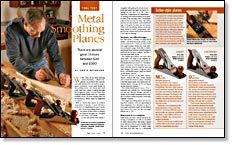Metal Smoothing Planes
There are several choices between $30 and $300
Synopsis: Smoothing planes are the primary means of surface preparation in Chris Gochnour’s shop. And after years of using them, he has lots of advice for those interested in buying one. First, look for a good-quality blade that can be sharpened to a keen edge and hold that edge for a substantial amount of time. Second, if it has a chipbreaker, make sure it’s well made. Third, you need a plane with a flat sole. With those criteria in mind, Gochnour tested eight Bailey- and Bedrock-style models and two low-angle models in price range from $30 to $300. He also gives tips on tuning up a bench plane.
When I first set up shop building custom furniture, I relied com – pletely on portable belt sanders and orbit sanders for all surface prepa – ration. However, I soon grew weary of the sanding woes—too much dust and noise, time and tedium working through the progressive grits. It never failed that when the finish finally went on, I became painfully aware of some sanding flaw I’d overlooked or planer snipe I’d neglected to remove.
With so much time spent on surface preparation, I needed a more effective method of accomplishing the task. I knew little about smoothing planes, but I was aware of their value to artisans throughout the ages, so I decided to give them a fair shake.
At first, the results were mixed. I struggled with getting the planes sharpened and tuned just right (for more on tuning, see the story on p. 79). I also strived to comprehend the importance of reading and understanding wood grain. In spite of the learning curve, I thoroughly enjoyed the journey. In time, the tuning process became routine, and understanding wood grain became second nature. Now I use smoothing planes as my primary means of surface preparation, and I get cleaner, crisper results in less time than I ever did by sanding.
Ten planes, four different designs
For this article, I looked at eight metal Bailey- and Bedrock-style planes in the most common No. 4 size—as well as two low-angle models. Within this wide selection and price range (from $30 to $300), everybody from hobbyist woodworkers to professional furniture makers can find a tool that suits their needs.
The Bailey-style planes can trace their roots back 125 years to an original designed by Leonard Bailey and made by the Stanley Rule and Level Co. The Bailey plane worked so well that little has been done over the years to improve upon its basic design. The Anant, Footprint, Groz, Kunz, and Stanley planes (right) are based on the Bailey pattern.
Around the turn of the 20th century, Stanley refined the basic Bailey design and created the Bedrock plane, declaring it the best plane made. The Clifton and LieNielsen planes (see pp. 76-77) are based on the Bedrock pattern.
The Veritas bench plane (see p. 77) is a uniquely 21st-century tool. It is not based on any one historic design; instead, it draws on successful elements from a variety of makers and incorporates some truly original concepts.
Low-angle smoothing planes are becoming more popular and are appealing in their simplicity. So I decided to try two low-angle smoothers made by Lie-Nielsen and Veritas (for more on the low-angle planes, see p. 78).
From Fine Woodworking #177
For the full article, download the PDF below:
Fine Woodworking Recommended Products

Marking knife: Hock Double-Bevel Violin Knife, 3/4 in.

Tite-Mark Marking Gauge

Starrett 12-in. combination square






















Log in or create an account to post a comment.
Sign up Log in